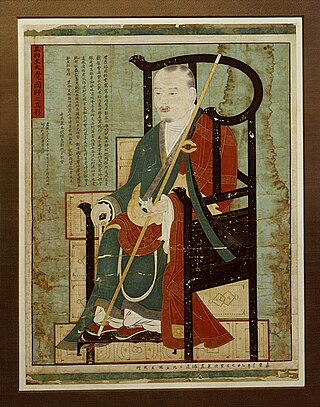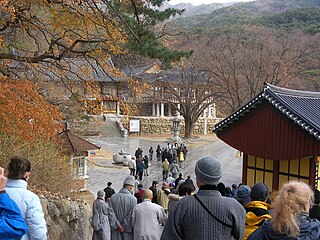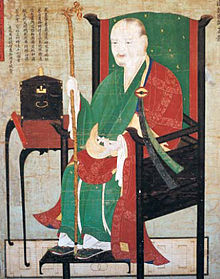Buddhist temples are an important part of the Korean landscape. Most Korean temples have names ending in -sa,which means "monastery" in Sino-Korean. Many temples participate in the Templestay program,where visitors can experience Buddhist culture and even stay at the temple overnight.

Taebong was a state established by Kung Ye on the Korean Peninsula in 901 during the Later Three Kingdoms.

The Later Three Kingdoms period of ancient Korea saw a partial revival of the old three kingdoms which had dominated the peninsula from the 1st century BC to the 7th century. After the Unified Silla kingdom had ruled Korea alone from 668,it slowly began to decline and the power vacuum this created led to several rebellious states rising up and taking on the old historical names of Korea's ancient kingdoms. A messy period of alliances and in-fighting followed,but one state would once again establish a dominant position—Goryeo,itself named in homage to the earlier northern Goguryeo kingdom—and form a unified Korean state and a dynasty which would last almost 500 years.
National Treasure (Korean: 국보) is a national-level designation within the heritage preservation system of South Korea for tangible objects of significant artistic,cultural and historical value. Examples of objects include art,artifacts,sites,or buildings. It is administered by the Cultural Heritage Administration (CHA). Additions to the list are decided by the Cultural Heritage Committee.

Uicheon was a Korean Royal Prince and influential Korean Buddhist scholar-monk during the Goryeo period (918–1392). He was the fourth son of King Munjong (1046–1083) and Queen Inye from the Gyeongwon Yi clan and the younger brother of Sunjong,Seonjong,and Sukjong.

Donghwasa (Korean: 동화사),also Donghwa Temple,is a Buddhist temple of the Jogye Order in northern Daegu,South Korea. The temple is located on the south side of Mt. Palgongsan,within the boundaries of Dohak-dong,Dong-gu,near Daegu's northern border. The name means "Temple of Paulownia Blossoms."

Beopjusa,is a head temple of the Jogye Order of Korean Buddhism. It is situated on the slopes of Songnisan,within Songnisan National Park,in Naesongni-myeon,Boeun County,in the province of North Chungcheong Province,South Korea.

Woljeongsa (Korean: 월정사) is a head temple of the Jogye Order of Korean Buddhism,located on the eastern slopes of Odaesan in Pyeongchang County,Gangwon Province,South Korea. Woljeongsa was founded in 643 by the Silla monk Jajang.

Yongjusa is a head temple of the Jogye Order of Korean Buddhism. It is located in on the slopes of Hwasan in Taean-eup,Hwaseong,Gyeonggi Province,South Korea.

Hwaeomsa is a head temple of the Jogye Order of Korean Buddhism. It is located on the slopes of Jirisan,in Masan-myeon,Gurye County,in South Jeolla Province,South Korea.

Guinsa,in the Yeonhwa area of the Sobaek Mountains located near Danyang in Chungcheongbuk-do,South Korea,is the headquarters of the Cheontae school of Korean Buddhism. Guinsa is the administrative center of over 140 sub-temples and hermitages of the Cheontae sect.

Unjusa or Unju Temple is a Korean Buddhist temple located in Hwasun County,South Jeolla province,South Korea. It is 26 km (16 mi) southwest of Hwasun County or 40 km (24 mi) south of Gwangju. Compared with other temples in South Korea,this temple has an unusual collection of stone Buddha statues and stone pagodas,so Unjusa is often referred to as the mysterious temple. Among several assumptions regarding its origin,the most widely known one is that Monk Doseon founded the temple based on geomancy during the late period of Silla Dynasty,but the origins remain unverified.

Shilleuksa is a Korean Buddhist temple situated against a low hill on the north side of the river Namhan,three kilometers east of Yeoju in Gyeonggi Province,approximately one-hour southeast of Seoul. The only riverside temple in South Korea,Shilleuksa is a sacred pilgrimage site and a repository of seven Treasures. A 500-year-old aromatic juniper tree and a 600-year-old ginkgo tree stand on the temple grounds.
Anhwa-sa is a Korean Buddhist temple located on Mt. Songak in the historic city of Kaesong,North Korea. Once one of the smallest of the many temples in Kaesong,today it is the only one to have survived the Korean War.
Geonbongsa (Korean: 건봉사) is a temple located in Goseong County,Gangwon Province,South Korea.

Saseongam (Korean: 사성암) is a Buddhist hermitage located in Gurye County on Mount Osan,a foothill of the mountain Jirisan in South Jeolla Province,South Korea.

Yongmunsa is a Buddhist temple of the Jogye Order in Yangpyeong county,South Korea.

Samhwasa is a Buddhist temple located in Gangwon,South Korea,affiliated with the Jogye Order of Korean Buddhism. Founded in 642 by Ven. Jajang Yulsa,the temple has undergone various transformations and played significant roles throughout Korean history. Its initial establishment as Heungnyeondae,later evolving into Samgongam Hermitage,reflects its shift from a doctrinal to a Seon School. The temple has been intricately linked with historical events,including prayers by Wang Geon for unification,and the water and land Ceremony following the establishment of Joseon. Despite suffering damages due to natural disasters and conflicts,including a fire set by the Japanese army in 1907,Samhwasa has been rebuilt and preserved,housing numerous cultural relics and national treasures. These include a Three-Story Stone Pagoda and an Iron Seated Rocana Buddha with significant historical and linguistic importance,showcasing the temple's cultural and historical significance in Korea.
Dogapsa is a Buddhist temple in South Jeolla Province in Yeongam County,South Korea.

Goryeo Buddhist paintings and architecture are prominent Korean art forms that are said to have originated in the 13 and 14th centuries. Known for their intricate depiction of Buddhist icons typically in the form of large hanging scrolls,artists made use of vibrant colors and adorned the patterns with gold. As Buddhism flourished as the official religion of the Goryeo Dynasty,various Buddhist artworks were produced under royal patronage and utilized for the purposes of state-sponsored ceremonies and funerary rituals. These paintings reflect not only the beliefs,but the taste and refine of the Goryeo royalty and nobility. Illustrations and decorative architectural styles often reflected the messages of Pure Land Buddhism or Amidism featuring Buddhas and Bodhisattvas;for instance,Avalokiteśvara,amongst others,were worshipped by their devotees to achieve the goal of rebirth in the ‘Pure Land’or paradise.














